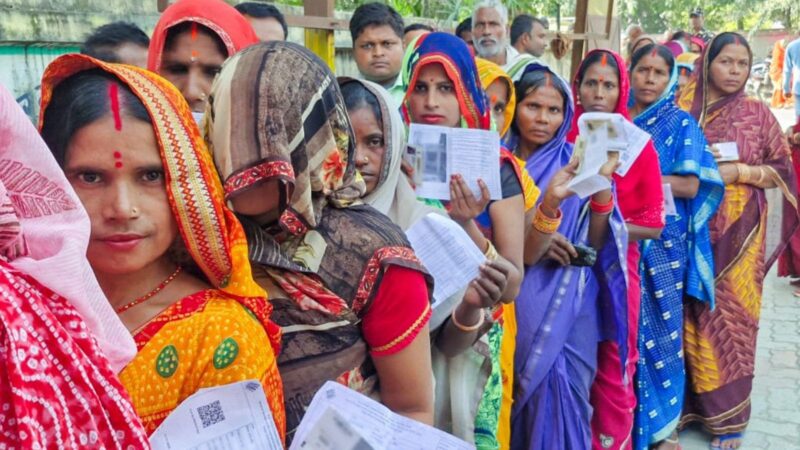
Nitish Kumar has been sworn in as the Chief Minister of Bihar for an unprecedented 10th term. In a ceremony attended by a large crowd and Prime Minister Narendra Modi, Nitish Kumar took the oath of office. Along with him, 26 ministers were sworn in, but only three women were included in the new cabinet. This brings the female representation in Nitish Kumar’s cabinet to just 11%. The inclusion of only three women in the cabinet has raised questions about gender representation in the government, especially considering the record voter turnout by women in the recent Bihar elections.
Women in Nitish Kumar’s New Cabinet
Out of the 26 ministers in Nitish Kumar’s new cabinet, only three women have secured positions. These three women ministers are Leshi Singh, Rama Nishad, and Shreyasi Singh. Their inclusion highlights the efforts to include women in leadership roles, but the overall percentage of women ministers remains low, especially considering the significant role that women voters played in the NDA’s victory in the 2025 elections.
Despite the low representation in the cabinet, the three women ministers have earned their place through significant victories in the state elections. The cabinet’s gender disparity has raised concerns about the adequacy of female representation in governance, particularly after women played a major role in determining the election results.
Leshi Singh: A Trusted Leader in Nitish Kumar’s Team
Leshi Singh, a six-time Member of the Legislative Assembly (MLA) from Dhamdaha, has retained her place in Nitish Kumar’s cabinet. She has been a trusted figure in the Janata Dal (United) party and served as the Minister of Food and Consumer Protection in the previous government. Leshi Singh won her seat in the 2025 elections by defeating RJD’s Santosh Kumar with a significant margin of 55,159 votes. Her political experience and leadership skills have made her an important part of Nitish Kumar’s team once again.
Her reappointment as a minister indicates the trust that Nitish Kumar has in her ability to handle important portfolios. Leshi Singh’s long-standing political career and her popularity in the Dhamdaha constituency have made her a key leader within the state government.
Shreyasi Singh: A New Minister from the BJP Quota
Shreyasi Singh, a new addition to the cabinet, has been inducted from the BJP’s quota. This is her first time serving as a minister. Shreyasi Singh, a former international shooter, contested and won the Jamui seat in the 2025 elections, defeating RJD’s Mohammad Shamshad Alam with a margin of 54,498 votes.
Shreyasi Singh’s background in sports and her transition to politics have made her a prominent figure in Bihar’s political landscape. Her appointment to the cabinet is seen as a step toward enhancing the representation of women in politics, especially in leadership roles. Shreyasi Singh’s victory and appointment are being viewed as a positive move toward greater female participation in governance.
Rama Nishad: A Political Veteran Joins the Cabinet
Rama Nishad, another woman inducted into the new cabinet, has a strong political background. She contested and won the Aurai constituency by a margin of 54,000 votes, defeating VIP’s Bhogendra Sahni. Rama Nishad is the wife of former BJP MP from Muzaffarpur, Ajay Nishad. Her victory in the 2025 elections highlights the growing influence of women in the political arena, especially in rural areas.
Rama Nishad’s inclusion in the cabinet brings additional political weight to the government. Her victory reflects her long-standing public service and the support she enjoys from her constituents. Her leadership will be crucial in addressing the needs and concerns of women in her constituency and beyond.
Women’s Crucial Role in NDA’s Victory
The success of the NDA in the 2025 Bihar elections, where the coalition secured 202 seats, can be attributed to various factors, with women’s support being a major contributing factor. Women voters, particularly those who benefited from Nitish Kumar’s welfare schemes such as the Jeevika program, played a significant role in the NDA’s triumph. The Jeevika program, which provides financial assistance to rural women through self-help groups, has been one of the key factors that garnered the support of female voters.
In this election, Bihar saw record voter turnout, with women participating in greater numbers than men. This high level of female voter turnout further emphasized the political power of women in the state. Despite this, their representation in the cabinet remains disproportionately low, leading to concerns about the inclusion of women in executive leadership positions.
Record Voter Turnout by Women in Bihar Elections
This year’s elections witnessed an unprecedented turnout, with women voting at a higher rate than men. The strong participation of women in the 2025 Bihar elections reflected their increasing political awareness and influence. Their support was crucial in helping the NDA secure a majority in the state assembly. However, despite their critical role in the electoral success of the NDA, the number of women ministers in the cabinet does not reflect their significant contribution to the victory.
The low percentage of women in Nitish Kumar’s cabinet—just 11%—has led to criticism of the government’s commitment to gender equality in leadership roles. While women voters were instrumental in the electoral outcome, their representation in the new cabinet is still far from adequate.
Gender Representation in Bihar’s Politics: A Long Way to Go
The gender imbalance in Nitish Kumar’s cabinet is a reminder that while female voter participation in elections is increasing, their representation in political offices remains limited. Despite the growing political influence of women, the barriers to their access to top leadership positions persist.
The inclusion of only three women ministers out of 26 in the new cabinet highlights the slow pace of progress toward gender equality in Bihar’s politics. The cabinet’s composition raises questions about how committed the government is to providing equal opportunities for women in positions of power.
While Nitish Kumar’s new cabinet includes three women ministers, the overall representation of women in governance remains low. The 2025 Bihar elections saw a historic level of female voter participation, which was a key factor in the NDA’s victory. However, the cabinet’s gender imbalance is concerning. The government must focus on increasing the number of women in leadership roles to ensure a more inclusive political landscape in the state.
The three women ministers—Leshi Singh, Shreyasi Singh, and Rama Nishad—have made significant strides in their political careers. However, the low percentage of women in the cabinet calls for a reassessment of how the government can better empower women and provide them with equal opportunities in governance. The hope is that in future elections and cabinets, women will have a more significant and equal representation in Bihar’s political leadership.
Share this:
- Click to share on WhatsApp (Opens in new window) WhatsApp
- Click to share on Facebook (Opens in new window) Facebook
- Click to share on Threads (Opens in new window) Threads
- Click to share on Reddit (Opens in new window) Reddit
- Click to share on Telegram (Opens in new window) Telegram
- Click to share on X (Opens in new window) X
- Click to share on LinkedIn (Opens in new window) LinkedIn


